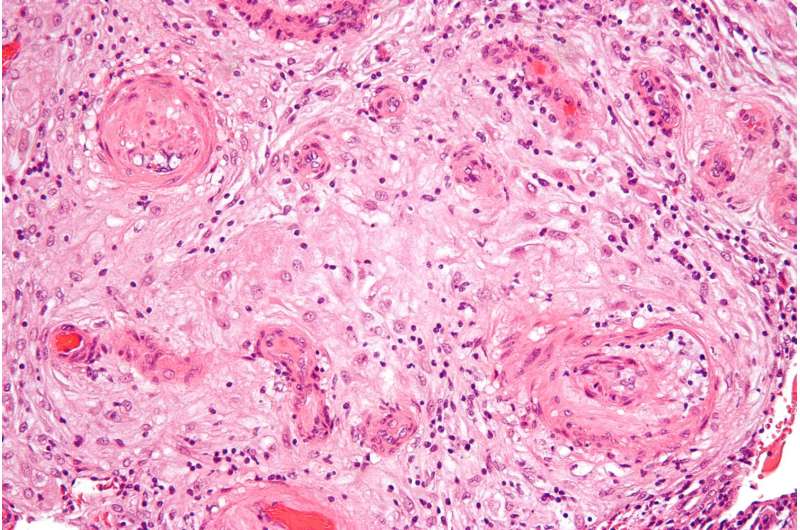Fetal genes can increase the risk of illness during pregnancy

A mother's risk of preeclampsia, a potentially life-threatening illness associated with pregnancy, can be linked in some cases to genes from her fetus. For the first time, a relationship has been found between fetal genes and the risk of preeclampsia in the mother. An international research collaborative has presented this finding in Nature Genetics, first published online earlier this summer.
Preeclampsia affects around 3 percent of births in Norway; worldwide, that number is estimated to be about 5 percent. In the vast majority of cases, the mother has mild symptoms, typically high blood pressure. Nevertheless, preeclampsia is one of the leading causes of death in both mothers and babies around the time of birth, and sometimes the only way to treat it is to deliver the baby, even prematurely.
Little studied
"For the first time ever, we have discovered a fetal gene that increases the risk of preeclampsia," says Ann-Charlotte Iversen at the Department of Clinical and Molecular Medicine at NTNU. She says there has not been much research on the role of fetal genes in triggering the illness.
Preeclampsia usually begins with a problem in the placenta, which is mainly composed of fetal cells. For that reason, it makes sense that fetal cells might have a hand in causing the illness, Iversen said, even though it is the mother's symptoms during the last part of the pregnancy that lead to the diagnosis.
The largest of its kind in the world
"Our findings are particularly solid for three reasons: We analysed a large number of individuals, we found several genetic variables that all point to the same gene associated with the risk, and two independent population studies confirmed that this gene is associated with the risk," Iversen said.
There are also a number of major studies that support the conclusions. CEMIR is one of 12 partners from six countries in an EU project called InterPregGen, which was created in 2011. "We are all working together to uncover the genetic risk factors for preeclampsia in the mother and fetus. We have linked a number of major European population studies to conduct the world's largest genetic study of preeclampsia," says Iversen. "Our contribution to the project has been information on a group of women from the HUNT study who have had problematic and healthy pregnancies, as well as information from the Preeclampsia Biobank, which has been collected independently."
The Nature Genetics article includes analyses of material from the Preeclampsia Biobank, including blood samples and tissue samples from placentas that have been collected at St. Olavs and Haukeland University Hospitals. The genetic variants identified by the researchers are associated with the FLT-1 gene, which encodes a protein that, in soluble form, is known as a biomarker for preeclampsia.
The protein contributes to damaging the mother's vascular system causing symptoms such as high blood pressure and an increased amount of protein in the urine. This happens as a result of problems with the placenta, essentially because fetal cells in the placenta produce the protein.
"We have shown here that the risk of disease may be because changes in the gene affect how the protein works and how it affects the mother. This is a fetal gene that gives the mother an increased risk of developing preeclampsia. This find clearly brings us closer to a better understanding of preeclampsia," Iversen said.
"The EU project has brought together geneticists, statisticians and clinicians. NTNU and CEMIR's expertise has been a complementary strength," says Iversen. Gabriela Silva, a PhD candidate, analysed the protein expression of FLT-1 in placental samples from sick and healthy pregnant women, while postdoctoral physician Liv Cecilie Vestrheim Thomsen was central in collecting the placentas.
"We have compared the result with the occurrence of the genes associated with the risk. This means that we have conducted a functional follow-up of the gene discovery, which has now been published," Iversen says.
Predicting which women will get sick
"CEMIR's Research Group for inflammation in pregnancy has a goal to figure out which disease mechanisms cause problems with the placenta and lead to the development of preeclampsia," says Iversen. The group is working to understand what goes wrong so they can detect problems early in a pregnancy. The goal is to predict which women will develop the disease.
"Our molecular analyses have identified specialized fetal cells in the placenta as the main actors in preeclampsia. These are the same fetal cells that have been identified with this new genetic discovery. This reinforces our conviction that fetal cells play an active role, and represents a big change in thinking, since research has previously focused most on the mother's immune system. If we want to prevent preeclampsia, we have to understand the foundation for the disease," says Iversen.
More information: Ralph McGinnis et al, Variants in the fetal genome near FLT1 are associated with risk of preeclampsia, Nature Genetics (2017). DOI: 10.1038/ng.3895

















